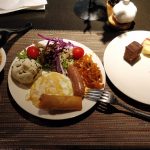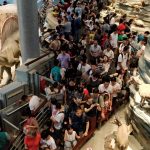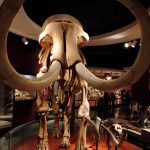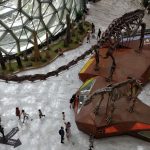Our class assembled for the final day of our field course at 9:00 AM today, after a scrumptious meal at the SSAW Boutique Hotel’s breakfast buffet. Although the skies were rainy, our spirits were high as we took taxis to the Shanghai Natural History Museum. One of the largest in the country, the Natural History Museum was established in 1956 and moved to its present building, a 40 000 m2 leviathan shaped partly like a nautilus, in 2015. The museum has a massive collection of 240 000 samples, featuring rare exhibits and taxidermy such as a giant panda, a mastodon skeleton and life-like animatronics of various dinosaurs. With the theme of “Nature, People and Harmony”, Shanghai Natural History Museum presents the mystery of origin, the long river of life, the way of evolution, colorful life, ecological vigor, survival wisdom, human and land, Shanghai story, future road, and the earth exploration through the three main lines of “evolutionary movement”, “picture of life” and “history of civilization”. The museum displays more than 11 000 specimen models from seven continents, including nearly 1000 specimens of rare species. There are nearly 1500 square meters of walk-in restoration scenes, vividly recreating the vibrant African savanna; The combination of multiple models and multimedia venues integrates into a technological yet intensely human feast for the senses.
We arrived, bought our tickets (12 RMB for students, 30 RMB full price), and set off to explore the museum at 10:30 AM. As it was the last Saturday before September, the museum was a veritable human sea, with over 4500 people packed within, out of a maximum capacity of 5700 by 11:00 AM. We squeezed our way into the second floor and the Mysterious Beginnings exhibit, which focused on the origins of the universe.
The universe originated from the Big Bang approximately 13.8 billion years age, and our planet formed 4.6 million years ago. Humans persistently pursue clues to the origins of the universe and life, and constantly propose various explanatory hypotheses, some of which have been supported and others debunked. The “Mystery of Origins” exhibition area led us to follow the footsteps of scientists and find all the answers together. Compress the Earth’s entire history into a single year, and multicellular organisms don’t appear in the ocean until late June. Land plants appear in late November, dinosaurs dominated the planet in mid-December, but then went extinct on Boxing Day, about the same time that the Rocky Mountains were uplifted. Early humans appear during the evening of December 31st.
The “Evolution Road” exhibition hall is on the basement level. It showed us the origin of life, changes in climate and terrain cause new species to evolve, and our evolution from pre-humans to modern Homo sapiens. The difference is that there is a video area behind each exhibition area. Perhaps this is the reason why there were so many people in this area, but it is not crowded. The exhibit that attracted us the most was the display on human evolution. Our common ancestors with modern apes already had flexible hands to climb and pick food. They gradually gained tool usage and bipedal locomotion. There was a damaged baby girl’s skull, which may have been the result of hawk predation. Then came the exhibit on early and late Homo sapiens. As the skull of the early H. sapiens is significantly different from late H. sapiens, it is considered to be an important transition in the evolution of human beings.
We left the museum at approximately 1 PM and found a quiet, tree-sheltered nook to hold the final discussion of our field course. Dr. Wang and Dr. Lougheed regaled us with the history of the China-Canada Biodiversity Field Course, the challenges of budgeting and logistics, equipment acquisition and gaining access to various venues. They told us about the mandatory field courses in the past and their transformative impact on students.
Though our time together was a mere 13 days, our diverse group of eight Canadian students, five 2+2 students, and three Chinese students built an everlasting bond forged through sweat, mosquito bites and last-minute seminar preparation. Our experiences together were indeed metamorphic, bridging viewpoints and upbringings separated by millennia of divergent cultural development and 12 time zones. We will carry what we’ve learned in this field course in our minds as we progress in our careers and fields, whatever they may be.
今天上午9点,我们的课程在柏阳君亭酒店享用了丰盛的早餐后,我们开启了野外课程最后一天的行程。虽然天空多雨,但我们的心里正艳阳高照。出租车把我们带到了上海自然历史博物馆。自然历史博物馆是中国最大的自然历史博物馆之一,成立于1956年,并于2015年搬迁至现在的建筑物,占地面积为40 000平方米,形似于鹦鹉螺。上海自然博物馆以“自然,人与和谐”为主题,通过“演化的乐章”、“生命的画卷”、“文明的史诗”三大主线,呈现起源之谜、生命长河、演化之道、大地探珍、缤纷生命、生态万象、生存智慧、人地之缘、上海故事、未来之路等10个常设展区。展馆陈列了来自七大洲的11000余件标本模型,其中珍稀物种标本近千件;近1500平方米的步入式复原场景,逼真再现生机勃勃的非洲大草原. 辅之以多媒体放映讲解,使整个展馆时代感鲜明又还原度极高,给我们的视觉和听觉带了冲击。我们到了,买了我们的门票(学生12元,全价30元),10:30开启了博物馆的探索之旅。由于这是九月之前的最后一个星期六,博物馆竟有了跨年夜“外滩”的感觉。到上午11点,最多可容纳5700人的展厅就以饱和。我们挤进了二楼的“起源之谜”展览。
宇宙起源于大约138亿年前的大爆炸,我们的星球则形成于460万年前。人类不断寻求宇宙和生命起源的线索,并不断提出各种解释性假设,其中一些得到了支持,另一些被推翻。 “起源之谜”展区让我们跟随科学家的脚步,一起找到了答案。将地球的整个历史压缩到一年,多细胞生物直到6月下旬才出现在海洋中。陆地植物出现在11月下旬, 恐龙在12月中旬统治了这个星球,但随后在节礼日灭绝,大致与落基山脉升起的时间相同。与人类相似的动物出现在12月31日晚上。
“演化之道”展厅在地下一层。这里讲述了生命的起源,因地形而造成气候的改变形成新的物种、以及从猿到人的演化历程。不同的是,展厅的每个展览区的背后都有视频区,也许这就是这个展厅人很多但又不至于拥挤的原因了。最吸引就是从猿到人的进化。猿人已经拥有灵活的双手去攀爬及采摘食物,渐渐地,他们能够使用工具,直立行走。这里有一块受损的女婴头骨,科学家猜想它可能是由于被鹰捕食。再到之后的早期智人和晚期智人。由于早期智人的头骨相较与之前有巨大飞跃,与晚期智人十分相似,所以被认为是人的进化史的重要过渡。
我们大约下午1点离开了博物馆,我们在一旁安静的小树林里找了块空地,以便对我们的田间课程进行最后的讨论。王博士和Lougheed博士向我们讲述了中加生物多样性实地课程的历史,预算编制,设备获取以及进入各个场馆的困难。他们向我们介绍了过去的必修课程及其对学生的变革影响。
虽然我们在一起的时间只有13天,但通过汗水,蚊虫叮咬和最后一分钟的研讨会,我们的8个加拿大学生,五个2 + 2学生和3个中国学生建立了永久的纽带。我们在一起互相交流,切磋观点,一同成长,这些观点和成长将经过千年的发展和12个时区的分离,并随着我们在职业和领域而发展。但无论它们是什么,我们在这次野外实习中学到的知识将永远伴随着我们。







Leave a Reply